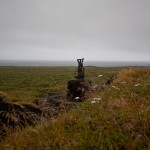Als Guðríður Þorbjarnardóttir von Island nach Nordamerika kam
Guðríður Þorbjarnardóttir ist eine der berühmtesten Frauen in der isländischen Geschichte.
Sie war die Mutter des ersten Europäers, der in Nordamerika (Vinland) geboren wurde und auf Reisen gab es keine Gleiche. Sie unternahm 8 Seereisen und durchquerte Europa zweimal, von Norden nach Süden und wieder zurück. Wahrscheinlich können alle Isländer ihre Vorfahren zu ihr zurückverfolgen.
Sie wurde in Laugarbrekka im späten 10. JH geboren. Um 1000 herum reiste sie mit ihren Eltern nach Grönland. Guðríður heiratete zuerst Þorsteinn, den Sohn von Eirik dem Roten, dem ersten Isländer, der sich in Grönland niederließ. Sie versuchten nach Vinland zu gelangen, scheiterten jedoch.
Eirik starb auf der Reise. Guðríður blieb in Brattahlið und lebte mit ihrem Schwager, Leifr der Glückliche Eiriksson, der als Erster die Neue Welt entdeckte. Hier traf sie den Händler Þorfinnur Karisefni, dessen Familie eine der nobelsten in dieser Zeit auf Island war. Er wollte gern in die Neue Welt fahren und auch Guðríður ermutigte ihn dies zu tun. Sie ließen sich dort für eine Weile nieder und Guðríður gebar dort auch ihren Sohn. Snorri war der erste Weiße, der dort geboren wurde. Doch die neuen Siedler kamen mit den Indigenen nicht zurecht und so entschieden sie sich wieder nach Grönland zurückzukehren und fuhren danach über Norwegen weiter nach Island. Als sie in Island ankamen, ließen sie sich in Glaumbær nahe Skagafjörður nieder.
Guðríður hatte jedoch ihre Reisen nicht aufgegeben. Nach dem Tod ihres Mannes Þorfinnur ging sie auf Pilgerschaft nach Rom. Auf ihrem Rückweg trat sie in ein Nonnenkloster ein.In den islandischen Sagas „Die Saga von Eirik dem Roten“ und „die Saga der Grönländer“ wurde Guðríður als eine Person mit großen Charakter, Intelligenz, Weisheit und Integrität beschrieben.










